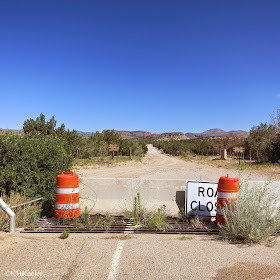Our friend
Sue Baum, spending six weeks in Santa Fe taking pottery classes at
Santa Fe Clay, was told not to miss the Kasha-Katuwe Tent Rocks, so we happily went along on her visit. The directions from Santa Fe were clear and the distance not far, but we still managed to take a series of wrong turns (picture below). On the trip back to Santa Fe we got it right the first time!
 |
| Road Closed! Eastern New Mexico |
Tent Rocks was worth the wrong turns we made before finding it.
 |
| Kasha-Katuwe National Monument, New Mexico |
There were strange and impressive formations, a combination of rock and sand, variously eroded. Kasha-Katuwe means "white cliffs" in the Keresan language of nearby Pueblo de Cochiti. Layers of volcanic deposits alternate, the harder layers protecting the softer from erosion.





